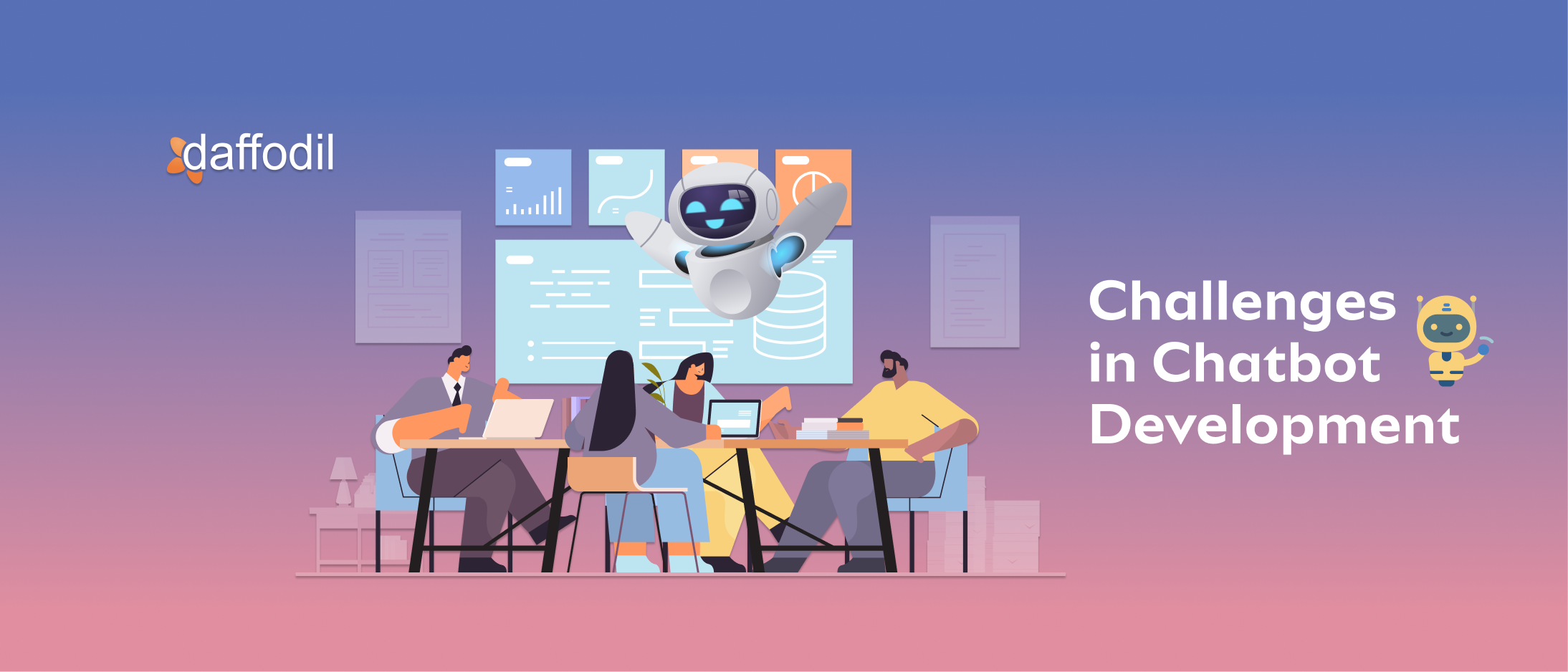
Chatbots have redefined the way customers interact with businesses. According to HubSpot, “47% of consumers are open to buying items through a chatbot”. Thus, majority of organisations have joined the race of augmenting or building these virtual agents on their websites.
The road towards the widespread adoption of chatbots is not all picture perfect, but comes with many roadblocks and pitfalls for you to be prepared of. There are numerous chatbot development tools and practices to take into account, however firms tend to overlook few critical aspects during chatbot development.
Here are 8 biggest challenges that companies face during chatbot development and ways to effectively tackle them.
1) Context in Chatbots
The key to the evolution of any chatbot is it’s integration with context and meaningful responses, as conversation without any context would be vague. It becomes challenging for companies to build, develop and maintain the memory of bots that offers personalized responses.
That’s when AI technologies like Machine Learning or NLP- Natural Language Processing come into the picture and overcome the challenge of understanding the depth of conversation; up-to an extent. NLP understands the databases and data sets when bots are structured, in predefined sequential order and then converts it into a language that users understand.
However, humans don’t interact in a defined order, as a result intelligent slot filling, which stores the preferences of the regular users is the alternative to maintain the memory of a bot effectively. This insures that your virtual agents are not interacting in the same old predefined order but in a more personalized fashion.
2) Context Retention Across Sessions
Maintaining context within a single conversation is one aspect, but carrying that context across different sessions or platforms presents another challenge. Users might start a conversation on a website and continue it later via a mobile app. Ensuring seamless continuity of context between these sessions is a complex problem.
For instance, if a user adds items to a shopping cart on a website and later interacts with the chatbot through a mobile app, the chatbot should recognize and continue the shopping context.
Develop a robust user profiling system that securely stores and retrieves user context across sessions. Utilize unique user identifiers and authentication mechanisms to link conversations seamlessly. Implement cloud-based storage for persistent data that can be accessed from different platforms.
3) Chatbot Testing
Chatbot testing is another main issue where most of the complexity lies. Chatbots are continuously evolving due to its upgradation in natural language models. Thus, it becomes vital to test and run chatbot to check it’s accuracy. Testing a chatbot will depend on what type of method you want to experiment.
- First method involves automated testing of chatbots. There are many automation testing platforms like Zypnos, TestyourBot, Bot Testing, Dimon etc. These platforms allow detailed reports of the results and coding of test scripts, which could be run for all the test cases.
- The other method involves testing of conversational logic i.e. manual testing executed by a closed group of testers. They act as users and check the bot for all the unexpected slots possible. This method can be time consuming and partially accurate. However, it has its own benefits that outrage automation, by checking the logic against human conversations.
The best alternative is to combine both the methods to insure that your users are being served better.
4) Viability of Data
There is no point of having lots of data, intelligent slot filling or technologically advanced chatbot- if it actually doesn't deliver the USP of your organization. It is vital for a chatbot to not only be enriched with meaningful data, but also to be equipped to deliver the brand identity to your target audience. In order to check the viability of your virtual agents you should consider asking yourself the following:
- Are your virtual agents delivering to the right audience?
- Does it offer business goals uniquely?
- How is it different from other chatbots?
5) Personalization and User Individuality
Every user is unique, with different preferences, communication styles, and expectations. The challenge in this aspect of chatbot development is creating a system that can accurately understand and adapt to these individual characteristics. It involves recognizing nuances in language, tailoring responses based on past interactions, and understanding user preferences.
For example, one user might prefer concise answers, while another may appreciate a more detailed explanation for the same query. The challenge is to make the chatbot capable of adapting its responses to suit the individuality of each user.
Overcoming the challenge of personalization involves creating robust user profiling mechanisms. By employing machine learning algorithms, developers can analyze user behavior, language nuances, and preferences to build detailed user profiles. Dynamic content generation techniques, based on these profiles, can tailor responses to each user's unique communication style. Continuous learning from user interactions ensures that the chatbot adapts to evolving preferences over time.
6) Integration with Third-Party Services
Chatbots are increasingly expected to go beyond simple informational interactions and perform tasks like making reservations, accessing external databases, or interacting with other services. The challenge here lies in seamlessly integrating the chatbot with a diverse array of third-party APIs and services. Each external service may have its unique data structures, authentication methods, and error-handling processes. Ensuring a smooth flow of information and actions between the chatbot and these services without compromising user experience is a complex task. For instance, integrating a chatbot with a hotel booking service involves handling availability checks, booking processes, and confirmation procedures, all of which may vary across different providers.
To achieve seamless integration with third-party services, developers should follow industry-standard API practices. Creating modular and flexible integration points can make it easier to connect with diverse external services. The use of middleware or integration platforms can help normalize data formats and authentication methods, streamlining the interaction between the chatbot and external APIs. Regularly updating the integration components to accommodate changes in third-party services ensures ongoing compatibility.
7) Limited User Attention
Users have limited time span for their queries and expect lightning-fast replies. It’s quite challenging for firms to develop chatbots, that holds user’s attention till the end.
Conversational UI, here plays an important role in exhibiting human like conversations and better customer experiences. It initiates interactions to be more social than being technological in nature. The conversations as a result, should be natural, creative and emotional in order for your chatbot to be successful. In some cases, however a machine wouldn’t always render the same empathy that a human could and this is when a human replacement should take care of the users request.
Also Read: Best Practices to Launch Chatbot for your Business
8) Dealing with Sensitive Information
Chatbots are often involved in handling sensitive user information, such as personal details, financial data, or health-related information. Ensuring the secure handling of this data and compliance with privacy regulations poses a significant challenge. Developers must implement robust encryption, authentication, and authorization mechanisms to protect user information. The challenge is further heightened when integrating with third-party services that may have different data protection standards.
Employ strong encryption algorithms to protect sensitive data during transmission and storage. Implement secure authentication and authorization mechanisms to control access to user information. Adhere strictly to data protection regulations and conduct regular security audits.
Begin Your Chatbot Development Journey
It may definitely seem to be a great idea to implement chatbot in your digital strategy, but creating a one that meets the expectations of your organization and users, is a big challenge. An effective and well planned strategy is important for you to consider before presenting the chatbot to your audience. If done well, chatbots can become the contact point for your business and can increase the overall productivity by meeting the customer’s on-demand expectations.
Looking for tailored chatbot solutions? Experience tangible results with our custom chatbot development services. Let's create a solution that fits – connect with us now!






